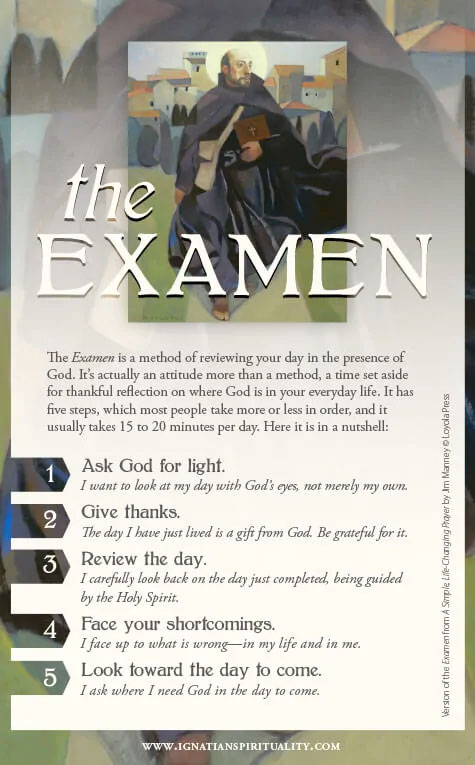By Gladyce Janky
St. Ignatius of Loyola, the founder of the Society of Jesus, pushed the Jesuits into the world to serve the poor and marginalized. He did not require his followers to stop throughout the day for prayer, which was the usual practice for vowed religious. Instead, he insisted that they practice the Daily Examen of Conscience. Over the centuries this prayer retains its original structure, with its focus shifting to awareness of consciousness or feelings and how these influence actions. It is a prayer that draws us to be more mindful of our emotions, to live in the present, noticing how feelings can influence our reactions to what we are experiencing. For those who practice this prayer, it is known as the Prayer that Changes Everything because it emphasizes self-understanding which leads to opportunities to deepen our friendship with God. The prayer has five steps.
First, I settle into a quiet space, shifting my attention from the world’s distractions and noticing that God is gazing lovingly at me. I ask God to accompany me as I review the events of my day, to help me see what is most important for my spiritual growth. When my mind is calm and more open to God’s presence, I am ready to proceed.
Second, I review my experiences since the last Examen, which could be yesterday, last week, or a more extended time frame. I let go of worrying about remembering these experiences. I remind myself that God will help me recall what is most important for my faith journey.
Third, I recall experiences of expressing love and care for others, feeling inner peace or joy, or feeling love and acceptance. I choose the memory that seems most affirming or has the strongest positive emotions. With God’s help, I relive these experiences through the lens of faith. I end by sitting quietly, listening for God’s response.
Fourth, I notice experiences when I was not at my best. Perhaps I felt drained, angry, or afraid. I might say to myself; I wish I had not said or thought that. I choose the experience with the most concern or weight, with the strongest emotional response. I do not judge what happened. I gently revisit these moments through the lens of faith. I end by sitting quietly, listening for God’s response.
Fifth, I turn my attention to tomorrow by setting an intention, such as being more present to my family, asking for God’s guidance, or something else.
An essential component is to end the prayer with an expression of gratitude for what God has revealed to me about myself. These affirming experiences with the strongest positive emotions offer insights into my “heart’s desires,” which God has planted in my soul. The challenging experiences, resulting in the “scratchiest” feelings, reveal where there is room to grow closer and more trusting of God.
A final element of the Examen is to journal what surfaces during prayer time. Periodically reviewing my journal helps me see patterns and becomes a source for spiritual discernment. This is also a way of “making peace” with my past. As Fr. Dennis Ham, SJ, explains, “There is a maxim today of living in the moment. This is a half-truth. We fall into the present and can be pushed around by it unless we have somehow dealt with the past and have taken a position about the future. Distracted by regrets and fears, we cannot be present. When we have prayed about the immediate past and future, we have sort of cleared the deck and can be present (Catholic Comments Podcast, July 2016).


